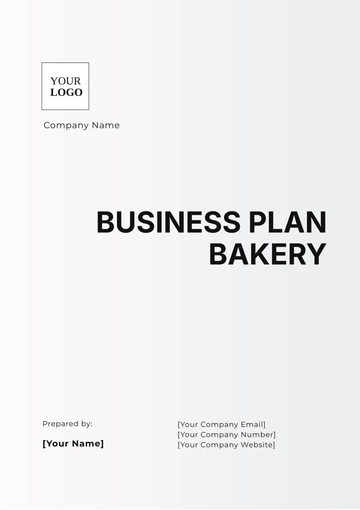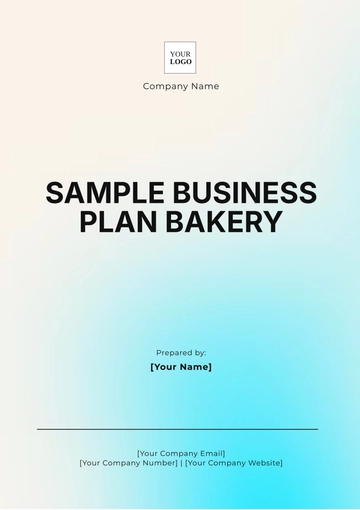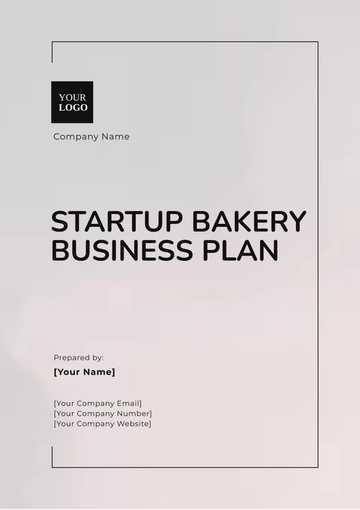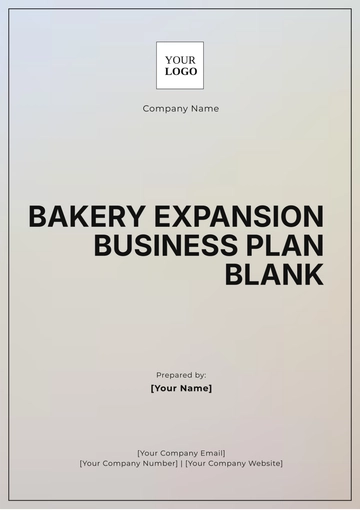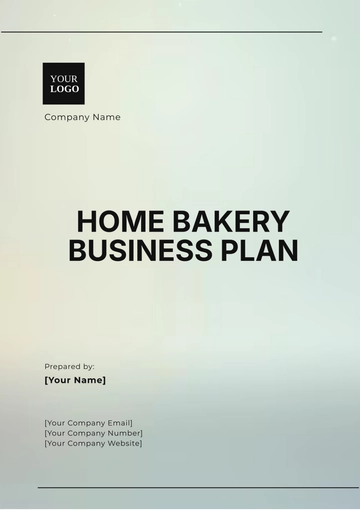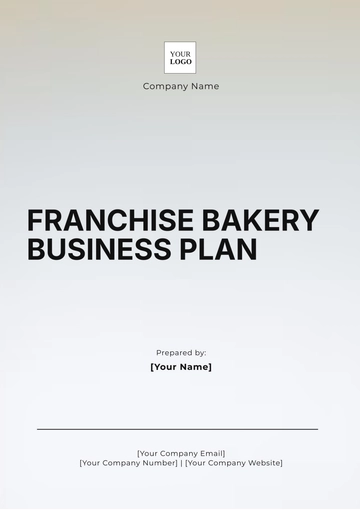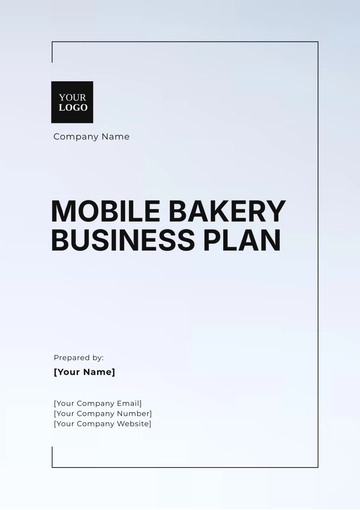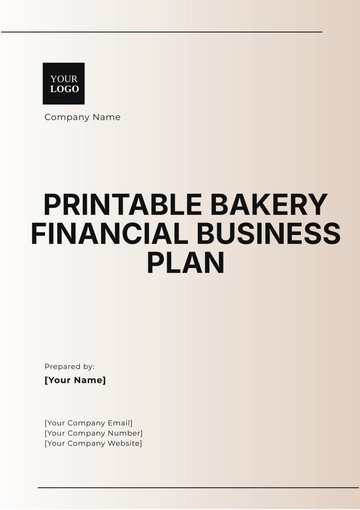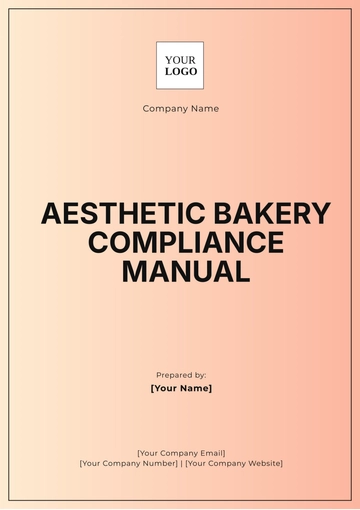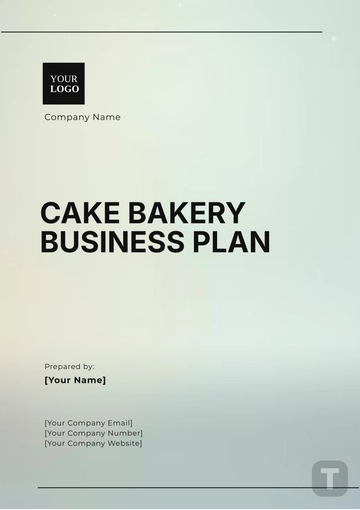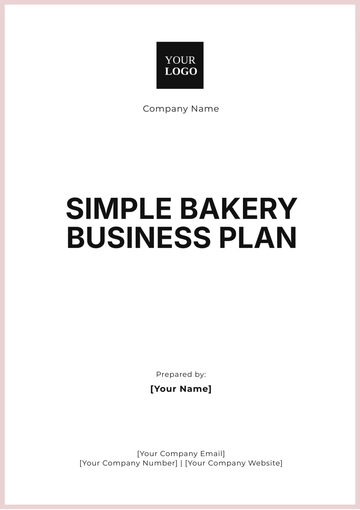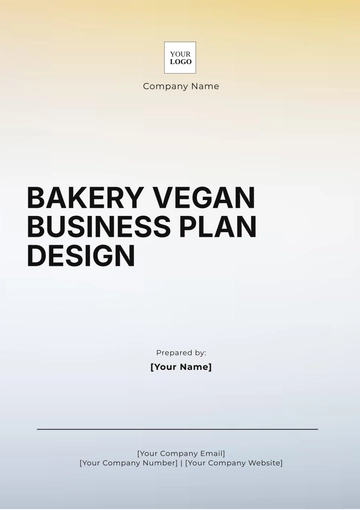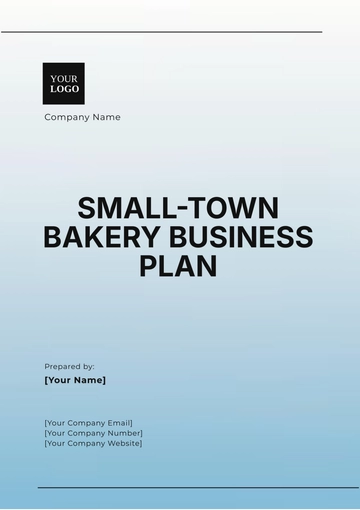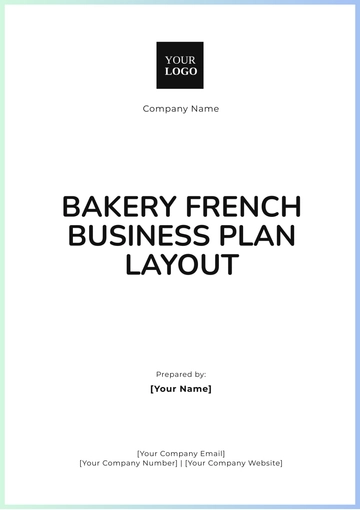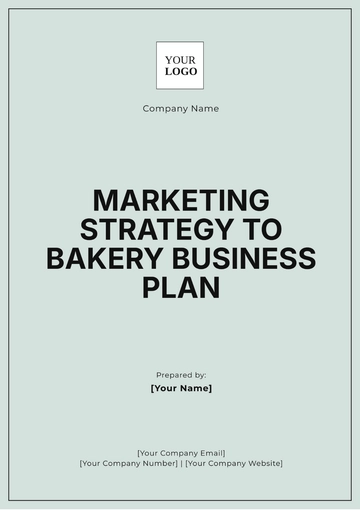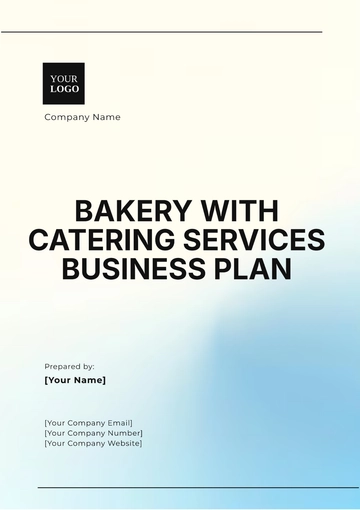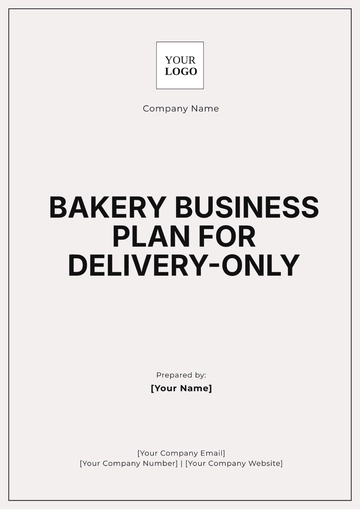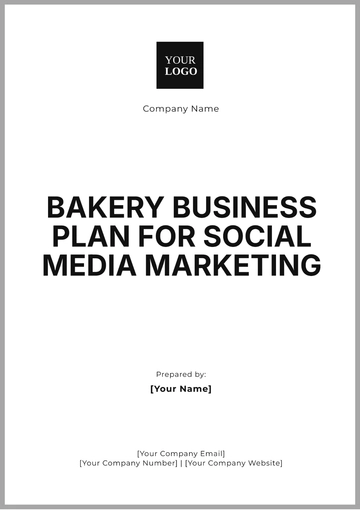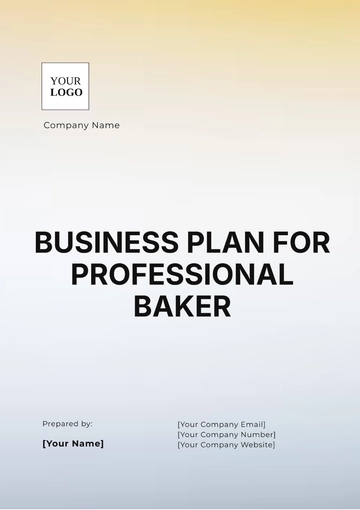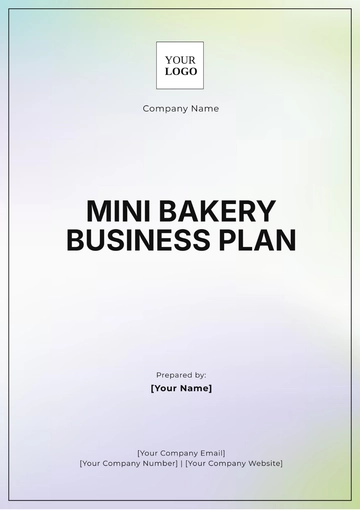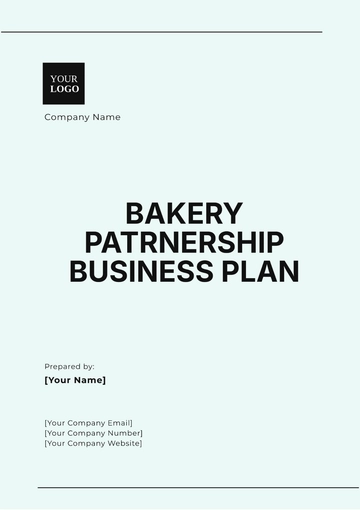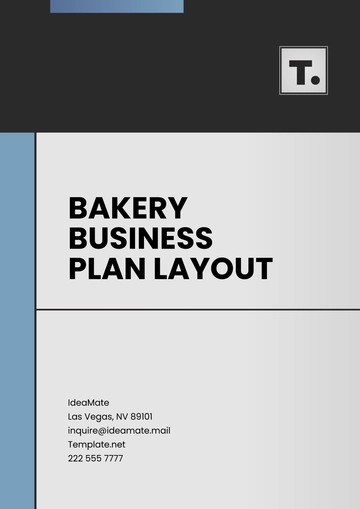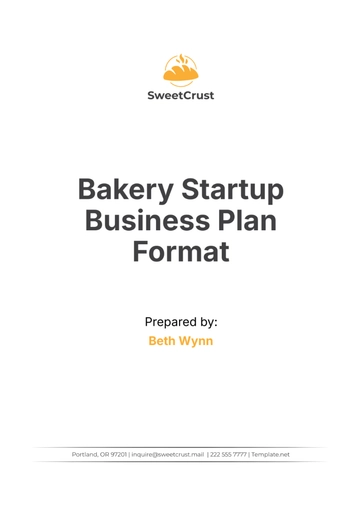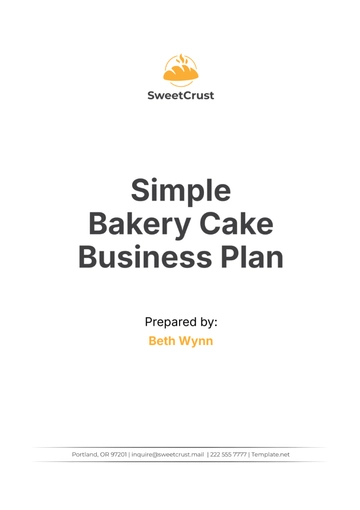Free Aesthetic Bakery Bread Business Plan
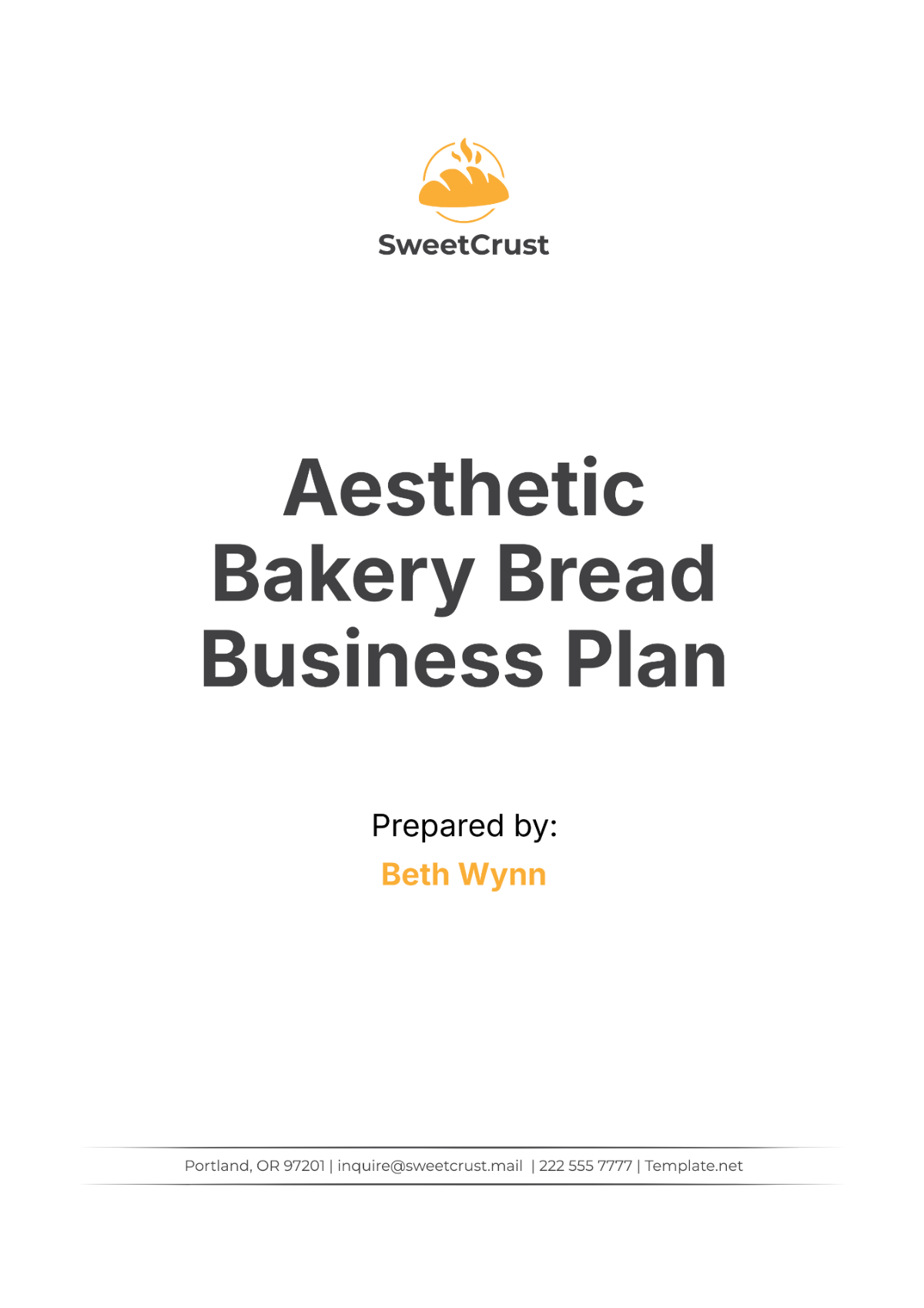
I. Executive Summary
[Your Company Name] is a dedicated bakery specializing in a variety of bread products. Our mission is to provide high-quality, freshly baked bread to our community, ensuring every loaf is crafted with care and passion. We aim to establish ourselves as a premier bakery in the area, offering a range of products that cater to diverse tastes and dietary needs.
Financially, we project a revenue of $500,000 in the first year, with a net profit margin of 15%. Initial investment requirements are estimated at $150,000, covering equipment, ingredients, and initial operating expenses. Our strategic location, coupled with a robust marketing plan, will drive customer traffic and sales growth. By the third year, we anticipate annual revenue to exceed $750,000, with continued growth expected as we expand our product line and customer base.
Key objectives include establishing a strong brand presence, securing a loyal customer base, and achieving financial sustainability. Our Bakery Bread Business Plan outlines the steps necessary to achieve these goals, including market analysis, operational strategies, marketing plans, and financial projections. Through careful planning and execution, we aim to create a thriving bakery that becomes a staple in the community.
II. Company Description
A. Mission Statement
Commitment to Quality: Our mission is to provide the highest quality bread products to our customers. We believe that every loaf of bread should be made with the finest ingredients and baked to perfection.
Community Engagement: We strive to be an integral part of the community, offering not just bread but a warm and welcoming environment. Our bakery will be a place where people gather, share, and enjoy.
Sustainability: We are committed to sustainable practices, using eco-friendly packaging and sourcing our ingredients from local suppliers whenever possible. This helps reduce our environmental footprint and supports local businesses.
Customer Satisfaction: Our customers are at the heart of everything we do. We aim to exceed their expectations with every visit, ensuring they leave satisfied and eager to return.
Innovation: We continuously seek to innovate and improve our product offerings. By staying attuned to market trends and customer preferences, we can introduce new and exciting products that keep our bakery fresh and relevant.
B. Business Structure
Ownership: [Your Company Name] is a privately-owned business, founded by experienced bakers with a passion for creating high-quality bread.
Management Team: Our management team consists of professionals with diverse backgrounds in baking, business management, and customer service. This ensures a well-rounded approach to running the bakery.
Staffing: We will employ a team of skilled bakers, customer service representatives, and support staff. Each team member will be trained to uphold our standards of quality and customer care.
Roles and Responsibilities: Each staff member will have clearly defined roles and responsibilities, ensuring efficient operations. Bakers will focus on product creation, while customer service staff will handle sales and customer interactions.
III. Market Analysis
A. Industry Overview
Bread Market Growth: The bakery industry has seen significant growth in recent years, driven by increased demand for artisanal and specialty breads. Consumers are increasingly seeking high-quality, fresh, and locally-sourced products.
Consumer Trends: Health-conscious consumers are driving demand for whole grain, gluten-free, and organic bread options. There is also a growing interest in ethnic and specialty breads, reflecting the diverse tastes of modern consumers.
Competitive Landscape: The bakery market is competitive, with both small artisanal bakeries and large commercial producers vying for market share. Our focus on quality, community engagement, and innovation will differentiate us from competitors.
Market Size: The local market for bread is substantial, with a diverse customer base that includes families, professionals, and food enthusiasts. We estimate a market size of $1,000,000 in our target area, with potential for growth as we expand our reach.
B. Target Market
Demographics: Our primary target market includes adults aged 25-55, with a focus on health-conscious individuals and families. This demographic values quality and is willing to pay a premium for artisanal products.
Psychographics: Our target customers appreciate fine foods and have a strong interest in health and wellness. They prefer products made with natural ingredients and are environmentally conscious.
Geographic Location: Our bakery will be located in a bustling urban area with high foot traffic. Proximity to residential neighborhoods, offices, and shopping areas will drive customer visits.
Behavioral Factors: Our customers are likely to be frequent buyers, visiting the bakery weekly or even daily. They value convenience, freshness, and the ability to purchase products that align with their dietary preferences.
C. Market Needs
Quality Products: There is a strong demand for high-quality bread made with natural ingredients. Consumers are increasingly aware of the health benefits of artisanal bread and are willing to pay a premium for it.
Variety: Customers seek a variety of bread options to cater to different tastes and dietary needs. Offering a diverse product range, including whole grain, gluten-free, and specialty breads, will meet this demand.
Convenience: Easy access to fresh bread is important to customers. Our location, combined with convenient operating hours, will ensure that customers can easily purchase our products.
Sustainability: Consumers are becoming more environmentally conscious and prefer businesses that practice sustainability. Using eco-friendly packaging and sourcing local ingredients will appeal to this segment.
IV. Products and Services
A. Bread Offerings
Artisanal Breads: Our core product line will include a variety of artisanal breads, such as sourdough, ciabatta, and baguettes. These breads will be made using traditional methods and high-quality ingredients.
Whole Grain Breads: We will offer a selection of whole grain breads, including whole wheat, multigrain, and rye. These breads cater to health-conscious customers seeking nutritious options.
Gluten-Free Breads: To meet the needs of customers with dietary restrictions, we will provide a range of gluten-free breads. These will be made in a dedicated gluten-free area to prevent cross-contamination.
Specialty Breads: Our specialty breads will include unique and seasonal varieties, such as pumpkin bread, olive bread, and jalapeño cheddar bread. These products will keep our offerings fresh and exciting.
Custom Orders: Customers will have the option to place custom orders for special occasions, such as birthday parties, weddings, and corporate events. This service will allow us to cater to specific customer needs and preferences.
B. Additional Products
Pastries: In addition to bread, we will offer a selection of pastries, including croissants, danishes, and muffins. These products will appeal to customers looking for a sweet treat or a quick snack.
Sandwiches: Our bakery will feature a variety of fresh sandwiches made with our bread. These will be perfect for customers seeking a convenient and delicious meal option.
Beverages: To complement our bread and pastries, we will offer a range of beverages, including coffee, tea, and fresh juices. This will enhance the customer experience and encourage longer visits.
Baking Supplies: We will sell baking supplies, such as flour, yeast, and baking tools. This will appeal to home bakers and enthusiasts who want to replicate our recipes at home.
C. Services
Baking Classes: We will offer baking classes to teach customers how to make their own bread at home. These classes will be a great way to engage with the community and promote our products.
Catering Services: Our bakery will provide catering services for events, offering a range of bread and pastry options. This will help us reach a wider audience and generate additional revenue.
Online Ordering: Customers will have the option to place orders online for pickup or delivery. This will provide convenience and accessibility for busy customers.
Loyalty Program: We will implement a loyalty program to reward repeat customers. This program will offer discounts, special offers, and exclusive products to our loyal customers.
V. Marketing Strategy
A. Branding
Brand Identity: Our brand identity will reflect our commitment to quality, community, and sustainability. This includes our logo, packaging, and overall aesthetic.
Brand Messaging: Our messaging will emphasize the quality of our products, our artisanal baking methods, and our dedication to the community. This will resonate with our target market.
Brand Story: We will share our brand story through various channels, highlighting our passion for baking and our journey to establish [Your Company Name]. This will create an emotional connection with our customers.
Customer Experience: We will ensure that every customer interaction reflects our brand values. From the layout of our bakery to the friendliness of our staff, every detail will enhance the customer experience.
B. Advertising
Local Advertising: We will use local advertising channels, such as newspapers, radio, and community boards, to reach our target market. This will help us build awareness in the community.
Online Advertising: We will invest in online advertising, including social media ads, Google ads, and email marketing. This will help us reach a broader audience and drive traffic to our website.
Promotions: We will run regular promotions and special offers to attract new customers and retain existing ones. This could include discounts, free samples, and loyalty rewards.
Partnerships: We will partner with local businesses and organizations to cross-promote our products. This will help us reach new customers and strengthen our community ties.
C. Social Media
Platforms: We will establish a strong presence on social media platforms, including Facebook, Instagram, and Twitter. These platforms will allow us to engage with customers and showcase our products.
Content Strategy: Our content strategy will include a mix of product highlights, behind-the-scenes looks, customer testimonials, and educational posts. This will keep our audience engaged and informed.
Engagement: We will actively engage with our followers, responding to comments and messages promptly. This will help us build a loyal online community.
Influencers: We will collaborate with local influencers and food bloggers to promote our bakery. Their endorsements will help us reach a wider audience and build credibility.
D. Community Involvement
Events: We will host and participate in community events, such as farmers markets, food festivals, and charity events. This will help us connect with the community and promote our brand.
Sponsorships: We will sponsor local events and organizations, such as sports teams and schools. This will increase our visibility and demonstrate our commitment to the community.
Workshops: We will offer workshops and classes on baking and nutrition. These events will educate the community and showcase our expertise.
Donations: We will donate bread to local food banks and shelters. This will help us give back to the community and align with our values of sustainability and compassion.
E. Public Relations
Press Releases: We will issue press releases to announce major milestones, such as our grand opening, new product launches, and community initiatives. This will generate media coverage and build awareness.
Media Relations: We will build relationships with local media outlets and journalists. This will help us secure coverage and establish ourselves as a trusted source for bread and bakery news.
Customer Testimonials: We will collect and share customer testimonials to build credibility and trust. These testimonials will highlight the quality of our products and the positive experiences of our customers.
Awards and Recognition: We will strive to earn awards and recognition in the bakery industry. This will enhance our reputation and attract new customers.
VI. Operational Plan
A. Production Process
Ingredient Sourcing: We will source high-quality ingredients from local suppliers. This ensures freshness and supports local businesses.
Baking Process: Our baking process will follow traditional methods, with each loaf carefully crafted by our skilled bakers. This ensures consistent quality and taste.
Quality Control: We will implement strict quality control measures to ensure that every product meets our high standards. This includes regular inspections and taste tests.
Packaging: Our packaging will be eco-friendly and designed to keep our products fresh. This aligns with our commitment to sustainability and customer satisfaction.
Inventory Management: We will use an inventory management system to track ingredients and products. This ensures that we maintain adequate stock levels and minimize waste.
B. Facility Management
Location: Our bakery will be located in a high-traffic area with ample parking. This ensures convenience for our customers and maximizes visibility.
Layout: The layout of our bakery will be designed for efficiency and customer experience. This includes a spacious kitchen, a welcoming storefront, and comfortable seating areas.
Equipment: We will invest in high-quality baking equipment to ensure efficiency and product quality. This includes ovens, mixers, and refrigeration units.
Maintenance: Regular maintenance of our equipment and facility will be conducted to ensure smooth operations. This includes cleaning, repairs, and upgrades.
Health and Safety: We will adhere to all health and safety regulations to ensure a safe environment for our staff and customers. This includes regular inspections and training.
C. Staffing Plan
Hiring: We will hire experienced bakers and customer service representatives. This ensures that we have the skills and expertise needed to deliver high-quality products and excellent service.
Training: New hires will undergo comprehensive training on our products, processes, and customer service standards. This ensures consistency and quality.
Scheduling: We will implement a flexible scheduling system to accommodate the needs of our staff and ensure adequate coverage during peak hours. This promotes work-life balance and efficiency.
Performance Management: Regular performance reviews will be conducted to provide feedback and support staff development. This helps in maintaining high standards and motivating employees.
Employee Benefits: We will offer competitive wages and benefits to attract and retain top talent. This includes health insurance, paid time off, and opportunities for career advancement.
VII. Financial Plan
A. Startup Costs
The following table chart and table outline the estimated startup costs for [Your Company Name]:
No. | Item | Cost |
|---|---|---|
1 | Lease and Renovation | $50,000 |
2 | Equipment | $40,000 |
3 | Initial Inventory | $10,000 |
4 | Marketing and Advertising | $20,000 |
5 | Working Capital | $30,000 |
Total | $150,000 |
The initial investment of $150,000 covers lease, renovation, equipment, inventory, marketing, and working capital. These costs are essential for setting up the bakery and ensuring smooth operations from day one. Lease and renovation are the largest expenses, reflecting the importance of securing and preparing an optimal location for our bakery. Equipment costs are also significant, emphasizing our commitment to high-quality baking tools to ensure product excellence. Marketing and advertising expenses highlight our focus on building brand awareness and attracting customers early on.
B. Sales Forecast
The following chart and table present our sales forecast for the first three years:
Year | Revenue | Cost of Goods Sold | Gross Profit |
|---|---|---|---|
1 | $500,000 | $200,000 | $300,000 |
2 | $600,000 | $240,000 | $360,000 |
3 | $750,000 | $300,000 | $450,000 |
Our sales forecast projects substantial growth over the first three years, with revenue increasing from $500,000 to $750,000. The gross profit margin remains consistent, reflecting effective cost management and pricing strategies. The cost of goods sold (COGS) is projected to rise proportionately with revenue, ensuring that our profit margins remain healthy. This steady increase in revenue is a positive indicator of market demand and our ability to attract and retain customers. The consistent gross profit growth underscores our operational efficiency and ability to scale our business.
C. Profit and Loss Statement
The following chart and table outline our projected profit and loss statement for the first year:
No. | Item | Amount |
|---|---|---|
1 | Revenue | $500,000 |
2 | Cost of Goods Sold | $200,000 |
3 | Gross Profit | $300,000 |
4 | Operating Expenses | $200,000 |
5 | Net Profit | $100,000 |
The first year’s profit and loss statement indicates a net profit of $100,000, with revenue of $500,000 and operating expenses of $200,000. This demonstrates a solid profit margin and effective cost control. Operating expenses include salaries, utilities, marketing, and other operational costs, which are managed to ensure profitability. The gross profit of $300,000 reflects our strong revenue generation and efficient production processes. Achieving a net profit in the first year is a strong indicator of our business's potential for financial sustainability and growth.
D. Cash Flow Statement
The following chart and table present our projected cash flow statement for the first year:
No. | Item | Amount |
|---|---|---|
1 | Cash Inflows | $500,000 |
2 | Cash Outflows | $400,000 |
3 | Net Cash Flow | $100,000 |
Our cash flow statement shows a positive net cash flow of $100,000, indicating healthy cash management and sufficient liquidity to support ongoing operations and growth. Cash inflows primarily come from sales revenue, while cash outflows include operating expenses and initial setup costs. Maintaining a positive cash flow is crucial for covering expenses, reinvesting in the business, and ensuring financial stability. This positive net cash flow provides a buffer for unexpected expenses and opportunities for future investments.
E. Break-Even Analysis
The following table outlines our break-even analysis for the first year:
No. | Item | Amount |
|---|---|---|
1 | Fixed Costs | $150,000 |
2 | Variable Costs per Unit | $2 |
3 | Sales Price per Unit | $5 |
4 | Break-Even Point (Units) | 50,000 |
The break-even analysis reveals that we need to sell 50,000 units to cover our fixed and variable costs. This metric helps us set sales targets and pricing strategies to ensure profitability. Fixed costs include rent, salaries, and utilities, while variable costs encompass ingredients and packaging. Understanding the break-even point is essential for strategic planning and financial forecasting. Achieving the break-even point within the first year demonstrates our potential for sustained profitability and growth.
The financial data indicate a strong foundation for [Your Company Name]. The initial investment is well-allocated to critical areas, ensuring that we are well-equipped to meet customer demand and maintain high product quality. Our sales forecast shows promising growth, driven by effective marketing strategies and strong community engagement. The profit and loss statement and cash flow statement both highlight our ability to generate substantial revenue while controlling costs, ensuring financial health and sustainability. The break-even analysis underscores our realistic sales targets and pricing strategies, providing a clear roadmap for achieving profitability.
VIII. Risk Analysis
A. Market Risks
Competition: The bakery market is highly competitive, with many established and new entrants. To mitigate this risk, we will focus on our unique value proposition, such as organic ingredients and artisanal methods, to differentiate ourselves.
Consumer Preferences: Changes in consumer preferences and trends can impact our sales. We will stay attuned to market trends and adjust our product offerings accordingly to meet evolving customer demands.
Economic Downturns: Economic downturns can reduce consumer spending, affecting our sales. We will build a loyal customer base and offer value promotions to retain customers during tough economic times.
Supply Chain Disruptions: Disruptions in the supply chain can affect our ingredient sourcing. We will establish relationships with multiple suppliers and maintain safety stock to mitigate this risk.
B. Operational Risks
Quality Control: Maintaining consistent quality is crucial for our reputation. We will implement strict quality control measures and regular training for our staff to ensure product excellence.
Staff Turnover: High staff turnover can disrupt operations and affect service quality. We will offer competitive wages, benefits, and a positive work environment to retain our employees.
Equipment Failure: Equipment failure can halt production and lead to financial losses. Regular maintenance and having backup equipment will help minimize this risk.
Health and Safety: Health and safety incidents can harm our staff and customers, as well as our reputation. We will adhere to all health and safety regulations and conduct regular training and inspections.
C. Financial Risks
Funding Shortfalls: Insufficient funding can hinder our growth and operations. We will secure sufficient startup capital and maintain a positive cash flow to support our business.
Cost Overruns: Unforeseen expenses can strain our budget. We will have contingency funds and closely monitor our expenses to stay within budget.
Credit Risks: Extending credit to customers can lead to bad debts. We will implement strict credit policies and conduct thorough credit checks to minimize this risk.
Interest Rate Fluctuations: Changes in interest rates can affect our loan repayments. We will opt for fixed-rate loans where possible and monitor interest rate trends to manage this risk.
D. Regulatory Risks
Compliance: Non-compliance with regulations can result in fines and legal issues. We will stay informed about industry regulations and ensure full compliance.
Licensing: Failure to obtain or renew necessary licenses can disrupt operations. We will keep track of licensing requirements and ensure timely renewals.
Labeling: Inaccurate labeling can lead to consumer mistrust and legal issues. We will ensure all product labels are accurate and comply with regulations.
Environmental Regulations: Non-compliance with environmental regulations can result in fines and reputational damage. We will adopt sustainable practices and stay informed about environmental regulations.
IX. Conclusion and Next Steps
A. Conclusion
[Your Company Name] is well-positioned to succeed in the competitive bakery market with our focus on high-quality, artisanal bread, and strong community engagement. Our Bakery Bread Business Plan outlines clear strategies for marketing, operations, and financial management, ensuring that we are well-prepared to achieve our goals.
By prioritizing quality, sustainability, and customer satisfaction, we are confident in our ability to build a loyal customer base and grow our brand. The financial projections demonstrate our potential for profitability and growth, while our risk management strategies ensure that we are prepared to navigate challenges and uncertainties.
B. Next Steps
The following steps outline our plan for the next phase of implementation:
Finalize Funding: Secure the necessary funding to cover startup costs and initial operations. This will ensure that we have the financial resources needed to execute our business plan effectively.
Lease and Renovate: Secure a suitable location for our bakery and complete the necessary renovations. This will create an inviting space for our customers and efficient workspace for our staff.
Hire Staff: Recruit and train skilled bakers and customer service representatives. This will ensure that we have a talented team to deliver high-quality products and excellent service.
Launch Marketing Campaign: Implement our marketing strategies to build brand awareness and attract customers. This will include social media marketing, community events, and collaborations with influencers.
Begin Operations: Launch our bakery and start production. This will mark the beginning of our journey to establish [Your Company Name] as a leading bakery in the market.
Monitor and Adjust: Regularly review our performance and make necessary adjustments. This will help us stay on track to achieve our goals and respond to any challenges that arise.
By following these steps, we are confident that [Your Company Name] will successfully launch and grow, providing high-quality bread and exceptional service to our customers.
- 100% Customizable, free editor
- Access 1 Million+ Templates, photo’s & graphics
- Download or share as a template
- Click and replace photos, graphics, text, backgrounds
- Resize, crop, AI write & more
- Access advanced editor
Create an appealing and effective business plan for your bakery with the Aesthetic Bakery Bread Business Plan Template! This template from Template.net offers editable and customizable features, allowing you to adapt it to your specific business needs and goals. The AI Editor Tool assists in crafting a well-organized plan effortlessly!
You may also like
- One Page Business Plan
- Coffee Shop Business Plan
- Restaurant Business Plan
- Food Business Plan
- Real Estate Business Plan
- Executive Summary Business Plan
- Cover Page Business Plan
- Nonprofit Business Plan
- Daycare Business Plan
- Construction Business Plan
- Startup Business Plan
- Medical Business Plan
- Bakery Business Plan
- Service Plan
- Hotel Business Plan
- Catering Business Plan
- School Business Plan
- Healthcare Business Plan
- Transportation Plan
- Sports Plan
- Car Wash Business Plan
- Salon Business Plan
- Clothing Business Plan
- Farming Business Plan
- Boutique Plan
